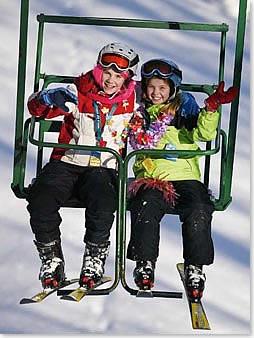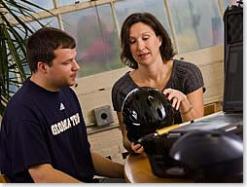One of the great advantages of growing up in New England is that there are a wide variety of outdoor recreational activities for kids to enjoy throughout the year. But some of the most popular activities can also pose the risk of significant injury.
"Typically, head injuries among children are much more common in the summer months when kids are out of school," explains Dr. Susan Durham, a pediatric neurosurgeon at Children's Hospital at Dartmouth-Hitchcock. "But in this region, we see just as many severe pediatric head injuries in the winter from skiing and snowboarding accidents. In fact, the leading cause of death among skiers and snowboarders is traumatic brain injury. Several recent studies suggest that head injury rates are higher for snowboarders than skiers."
This trend has so concerned Durham that she has teamed up with Aaron Buck and Richard Greenwald, PhD, from Simbex—a biomedical research company that uses scientific data to develop products for consumer use—to better understand how head injuries occur in snowboarding. "We're three years into a five-year study at Whaleback Mountain Resort in Enfield, comparing head impact data with factors like age, gender, and skill level," she says.
Snowboard helmets mounted with advanced sensor technology provide key data on how head injuries occur.
How they fall
The development of terrain parks, improvements in equipment and technology, and a predominantly young male population have all contributed to make snowboarding a high-risk activity. "We also know that snowboarders tend to fall a lot more often, whereas skiers tend to collide with things, so the mechanisms of injury are very different," says Durham. "But no one really knows what happens when they fall."
To conduct its study, the project team has been outfitting volunteer participants with standard Giro® snowboard helmets containing the Simbex Head Impact Telemetry (HIT) System. "We've mounted miniature sensors called "accelerometers" into the padding of the helmets to record the rapid movement of the head that occurs under impact conditions," explains Greenwald, president of Simbex and developer of the HIT system.
"If we can understand how these impacts cause injuries, then we can start to better understand how to develop technologies to prevent them," adds Greenwald, who also serves as an adjunct associate professor at Dartmouth's Thayer School of Engineering.
Jonathan Beckwith, senior research engineer from Simbex, and pediatric neurosurgeon Susan Durham, MD, discuss study results.
Better safe than sorry
So far, the group has collected data for 130 rider days, recording a total of 357 head impacts (with no injuries). While the conclusions are still preliminary, they are telling.
"The data is showing that youth snowboarders sustain significant head impacts (greater than 50 g-forces)," says Durham, who presented the study results at both the International Ski Safety Symposium and the Annual Meeting of Pediatric Neurosurgeons this past year. "We're also finding that male riders suffer more impacts than female riders, and that the rate and severity of impacts increase with advancing skill level. Interestingly, the most common location of impacts is in the front of the head, not in the back of the head as many people would assume."
"I think the main message that we'd like to convey through this is that head injuries from snowboarding are real, and that they're serious," she says. "Tragically, we see kids every year who die from them. It's critically important for kids and families to be aware of this fact and for kids to wear a helmet when they're out on the slopes—it can make all the difference."


